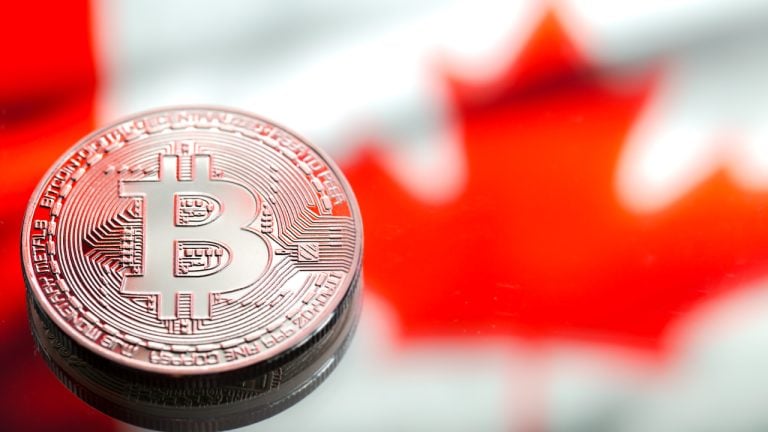 The Bank of Canada has announced a strategic shift away from developing a retail Central Bank Digital Currency (CBDC) to focus on broader payments system research and policy development. This decision follows a public consultation in 2023, which revealed significant privacy concerns among Canadians. While the central bank remains open to revisiting the idea of […]
The Bank of Canada has announced a strategic shift away from developing a retail Central Bank Digital Currency (CBDC) to focus on broader payments system research and policy development. This decision follows a public consultation in 2023, which revealed significant privacy concerns among Canadians. While the central bank remains open to revisiting the idea of […]

Bank of Canada Governor Tiff Macklem highlighted the potential risks AI poses to inflation and financial stability in the short term.
Bank of Canada Governor Tiff Macklem said that investments in artificial intelligence may lead to higher inflationary pressures in the short term and cause financial stability issues.
According to Macklem, AI may also affect how businesses set prices. There is already evidence that digitally intensive firms adjust prices more often than less digitally focused ones.
“Central banks need to be closely attuned to how AI is affecting inflation, both indirectly through overall demand and supply and directly through price-setting behavior,” Macklem said.

Regulating and speeding up payments without a CBDC are more important to the Canadian central bank.
The Bank of Canada is winding down its work on retail central bank digital currency (CBDC), according to an update to the central bank’s website. The announcement did not mention wholesale CBDC, but it emphasized that its research was continuing.
The Bank of Canada has done extensive research on CBDC and is now shifting its focus from CBDC research to other more pressing issues.
The Bank of Canada’s position on CBDC was that it needed a “contingency plan” in case it became necessary. The current shift in focus comes as the bank prepares for new responsibilities. The Bank of Canada said:

The staff note suggested that although the DeFi ecosystem brings a ton of innovations in the financial sector the regulatory challenges and vulnerability limit its potential use in traditional finance.
The Central Bank of Canada published a staff note on Decentralized Finance on Oct. 17, assessing the innovations that made it popular and the challenges and risks associated with its use.
The staff note described DeFi as a multi-layered structure with the Ethereum blockchain serving as the bottom layer (or settlement layer). Developers construct a variety of tools and services on top of the main blockchain including tokenization, lending and borrowing services, and much more.

The staff note shed light on the rise in popularity of the DeFi ecosystem starting in 2020 and how it became an integral part of the crypto economy with billions in volume over the next few years. The popularity of the ecosystem took a dip starting in 2022 with the collapse of multiple key crypto platforms with significant DeFi exposure including Terra-Luna.
Talking about the key features of the decentralized ecosystem, the staff note lauded DeFi’s “composability,” which allows the apps and services in the ecosystem to interconnect. The Bank of Canada note highlighted three of the key areas where DeFi can transform the financial system
Apart from the key DeFi innovations that can transform the traditional financial system, the staff note also talked about the challenges and risks associated with the DeFi ecosystem claiming that “despite its innovations and possibilities, the overall economic benefits of DeFi remain limited.”
Related: Bank of Canada emphasizes need for stablecoin regulation as legislation is tabled
The note lists three key challenges that the DeFi system faces today: The lack of real-world tokenization, the higher concentration of interconnection within and its dependence on the unregulated centralized finance ecosystem.
The note also highlighted the regulatory challenges posed by the DeFi ecosystem and the rise in vulnerabilities in the ecosystem leading to several hacks and exploits. The note claimed that “the anonymous and borderless nature of public blockchains complicates regulatory oversight.”
Magazine: US enforcement agencies are turning up the heat on crypto-related crime

A central bank discussion paper found that the majority of Canadians have little trouble accessing financial services, which gives them little reason to use a CBDC.
The typical Canadian has little reason to adopt a central bank-issued digital currency, which could cause problems with its broad acceptance, according to a new paper from the Bank of Canada.
In the staff discussion paper released on Aug. 10, the central bank looked at a hypothetical scenario where cash was virtually eliminated in order to see what role a potential CBDC could play in helping the underbanked.
It found that most consumers would have “weak incentives” to use one, as Canadians don't face meaningful barriers to financial services like bank accounts or debit and credit cards.
98% of Canadian adults have a bank account, 87% also have a credit card and 90% of rural and urban households combined can access high-quality internet, the paper said.
It however found that replacing cash with digital loonies would also mean tech-averse Canadians would have fewer payment options while cash-dependent Canadians would find themselves unable to make the most common payments.
The potentially low uptake of a CBDC would also lead to merchants unlikely to want to accept one which would further diminish its usefulness.
Our latest survey results show that 92% of merchants have no plans to go cashless.
— Bank of Canada (@bankofcanada) August 8, 2023
Read more results from our survey: https://t.co/DX0lUJ90u7#cdnecon #PaymentMethods #Survey pic.twitter.com/017UYxiIC4
Instead, the paper floated non-CBDC-related ways that could better help the underbanked — including improving internet access, expanding low-cost bank account availability, increasing merchant collaboration with remote communities and continuing to supply cash.
The paper stressed it was not predicting how Canadians would react to a CBDC and said more could be interested in using it due to a variety of reasons.
Even if there was greater interested than it suggested, the paper added the barriers for both users and merchants to broadly adopt a CBDC “appear to be significant.”
The paper also gave a strong nod to the necessity of cash, noting that without cash there would be no offline payment methods in emergency situations such as extreme weather or widespread power outages.
Related: ‘No fucking way’ — Joe Rogan, Post Malone slam US government CBDC
“This suggests the potential system-wide benefits of encouraging digital payment innovations that can function offline as well as the importance of sustaining cash,” it explained.
The paper claimed such a scenario highlighted the importance of the Bank of Canada continuing to issue cash and providing cash accessibility.
The paper noted the central bank previously stated it was committed to supplying cash as long as it was in demand and a CBDC would only be issued with the advent of a cashless society or the widespread use of foreign CBDCs or cryptocurrencies such as Bitcoin (BTC).
Asia Express: China expands CBDC’s tentacles, Malaysia is HK’s new crypto rival

The biggest motivation for Canadians interested in Bitcoin is an investment — as showcased by the choice of over one-third of the 4,996 respondents in the Bank of Canada's 2022 survey.
The Bank of Canada (BOC) reported a decline in the ownership of Bitcoin (BTC) and cryptocurrencies in the country last year as neither market conditions nor regulations sided in the favor of Canadian crypto investors, according to a BOC study published last week.
The annual Bitcoin Omnibus Survey (BTCOS) conducted by the Canadian central bank showed a relapse from the massive crypto adoption witnessed in 2021.

The above graph shows that — halfway into 2022 — Bitcoin ownership in Canada declined to 9% by August. Although BTC adoption saw a slight uptick to 10% by the end of the year. However, the drop in Bitcoin ownership does not imply that investors were spreading out their investments into other cryptocurrencies. The report read:
“Investors did not appear to shift out of Bitcoin and into other cryptoassets, as we observe decreased ownership of altcoins.”
The biggest motivation for Canadians interested in Bitcoin is an investment — as showcased by the choice of over one-third of the 4,996 respondents in the BOC survey.

Most Canadians acquired their crypto holdings through mobile and web apps. Bitcoin and crypto mining became the third-most-popular method of accumulating tokens for the second consecutive year.
When it comes to the altcoin ecosystem, Dogecoin (DOGE) was the most sought-after crypto investment considering the Elon Musk-induced hype and its history of randomly skyrocketing in price. Ether (ETH), Bitcoin Cash (BCH) and Litecoin (LTC) were some of the other popular altcoins for Canadians.
Related: Parliamentary report recommends Canada recognize, strategize about blockchain industry
According to the BOC, the research is relevant for monitoring the two conditions that could warrant the issuance of an in-house central bank digital currency (CBDC): “if Canadians almost or do stop using cash, or if Canadians widely adopt and use private cryptocurrencies for payments.”
Hey Canada, we need your input!
— Bank of Canada (@bankofcanada) May 8, 2023
Our public consultation on a potential #DigitalCanadianDollar is now LIVE. #HaveYourSay by June 19: https://t.co/p8BdG3tQ9h pic.twitter.com/vKRoBfAngu
BOC highlighted that ecosystem collapses, along with regulatory hurdles and price depreciation contributed to the decline in crypto ownership. However, considering the government’s intent to provide regulatory clarity combined with a stable market, the crypto ownership in the region is expected to pick up as well.
Magazine: Deposit risk: What do crypto exchanges really do with your money?

Canadians are being asked what features they wish to see in a digital Canadian dollar even though there are no plans yet to issue one.
Canadians are being asked to submit what features they want to be included in a potential digital Canadian dollar, with the country’s central bank opening a consultation to the public.
On May 8, the Bank of Canada (BoC) launched a public consultation that will run until June 19, noting it’s exploring a virtual loonie as “the world becomes increasingly digital.”
The BoC’s senior deputy governor Carolyn Rogers said in a statement the bank wants to hear what Canadians “value most in the design of a digital dollar” to help it make choices relating to its security and reliability along with ensuring it “meets the needs of Canadians.”
Hey Canada, we need your input!
— Bank of Canada (@bankofcanada) May 8, 2023
Our public consultation on a potential #DigitalCanadianDollar is now LIVE. #HaveYourSay by June 19: https://t.co/p8BdG3tQ9h pic.twitter.com/vKRoBfAngu
The bank was quick to state that it's not starting work on a central bank digital currency (CBDC) and wasn’t looking to replace cash if it does.
“At this time, a digital Canadian dollar is not needed. And any decision to issue one rests with Parliament and the Government of Canada.”
“Cash isn’t going anywhere,” the BoC added. It said, however, that many Canadians could be excluded from the economy in the future if the use of banknotes falls.
If a CBDC was issued, physical notes would still be provided “for those who want them” the bank said.
The BoC also outlined the possibility that cryptocurrencies or foreign CBDCs “could become widely used in Canada.”
It claimed this scenario could compromise the Canadian dollar and “pose a risk to the stability of our financial system.”
Related: Retail CBDCs bring unknown ‘consequences’ to financial system — IMF director
The consultation’s questionnaire asks Canadians a wide range of questions including the payment methods they’ve used in the last month, how often they would potentially use a Canadian CBDC and what design features they wish to see.
It also specifically asks if the survey taker uses or holds cryptocurrencies and features a range of demographic questions about gender, age, education and income.

The BoC said it will publish a report summarizing the consultation “later this year.”
Hall of Flame: Crypto Wendy on trashing the SEC, sexism, and how underdogs can win

Despite banking laws stating that remedies should not be aimed at benefiting a specific bank, this change could be structured “in a way to ensure” First Republic benefits, according to unnamed sources.
United States authorities are reportedly deliberating on "expanding" an emergency credit line for banks, which may provide First Republic Bank a time buffer to address balance sheet concerns, according to people familiar with the situation.
In a March 26 Bloomberg report citing unnamed sources, it was reported that U.S. officials are ruminating on what support, "if any," can be provided to First Republic, however an “expansion of the Federal Reserve’s offering” is one of the options being explored.
First Republic was reportedly deemed “stable enough to operate” by regulators without the need for an “immediate intervention,” as efforts are made by the bank in the meantime to “shore up its balance sheet.”
The sources noted that while the Fed’s liquidity offerings would be reportedly expanded in accordance with banking law, which stipulates that it must be “broadly based” and not aimed at benefiting a specific bank, they also warned that the alteration could be “made in a way” that ensures First Republic Bank benefits.
Related: Let First Republic and Credit Suisse burn
It was reported that despite First Republic facing structural challenges with its balance sheet, "the bank's deposits are stabilizing” and is not at risk of experiencing “the kind of sudden, severe run” that led regulators to close down Silicon Valley Bank. It noted:
“It has cash to meet client needs while it explores solutions, the people said. That includes $30 billion deposited by the nation’s largest banks this month.”
This comes after the Fed announced a plan on March 19 to strengthen liquidity conditions through “swap lines," which involve an agreement between two central banks to exchange currencies.
Coordinated central bank action to enhance the provision of U.S. dollar liquidity: https://t.co/Qs4cYY8BFO
— Federal Reserve (@federalreserve) March 19, 2023
"To improve the swap lines’ effectiveness in providing U.S. dollar funding, the central banks currently offering U.S. dollar operations have agreed to increase the frequency of seven-day maturity operations from weekly to daily," the Fed said in a statement
The swap line network – which involves the Bank of Canada, Bank of England, Bank of Japan, European Central Bank, and the Swiss International Bank – commenced on March 20 and is set to run until at least April 30.
 On Sunday evening, March 19, 2023, at 5:00 p.m. Eastern Time, the U.S. Federal Reserve, along with several central banks including the Bank of England, Bank of Canada, Bank of Japan, the European Central Bank, and the Swiss National Bank, announced a coordinated action to enhance the provision of liquidity via the standing U.S. dollar […]
On Sunday evening, March 19, 2023, at 5:00 p.m. Eastern Time, the U.S. Federal Reserve, along with several central banks including the Bank of England, Bank of Canada, Bank of Japan, the European Central Bank, and the Swiss National Bank, announced a coordinated action to enhance the provision of liquidity via the standing U.S. dollar […] This week researchers from the Bank of Canada published the central bank’s Financial System Review which highlights five key statistics tethered to Canadian bitcoin owners. According to the Bank of Canada’s metrics, 13% of Canadians own the leading crypto asset bitcoin, and “most Canadians are aware of bitcoin.” Bank of Canada’s Financial System Review Highlights […]
This week researchers from the Bank of Canada published the central bank’s Financial System Review which highlights five key statistics tethered to Canadian bitcoin owners. According to the Bank of Canada’s metrics, 13% of Canadians own the leading crypto asset bitcoin, and “most Canadians are aware of bitcoin.” Bank of Canada’s Financial System Review Highlights […]